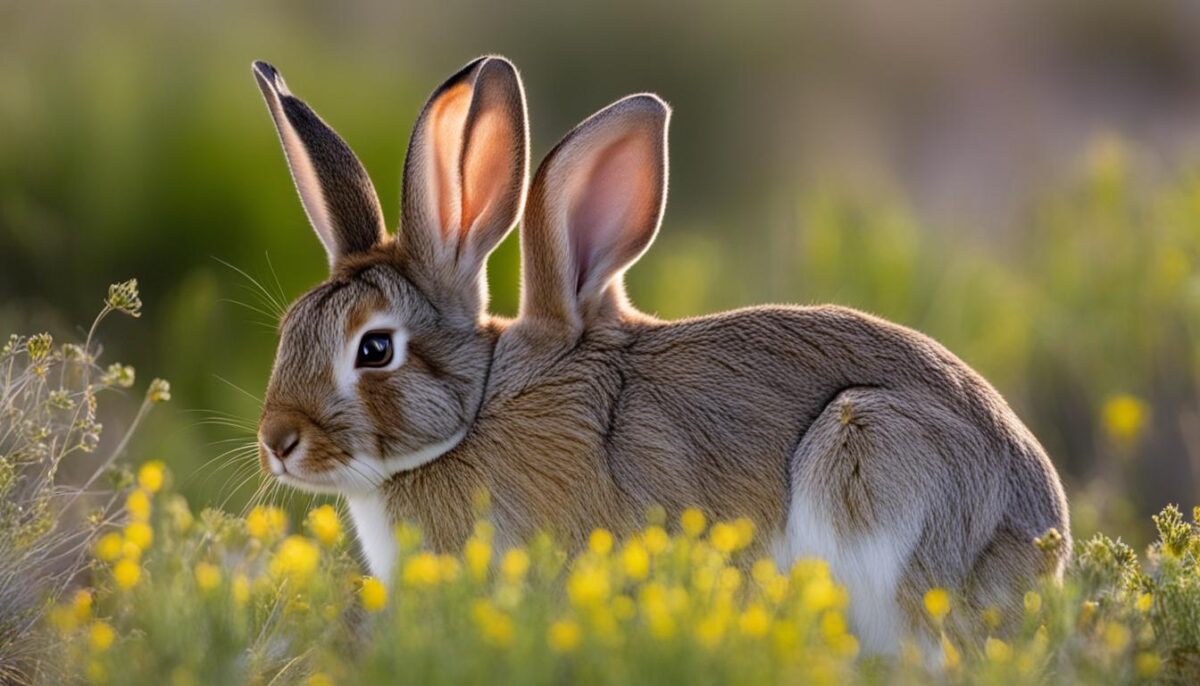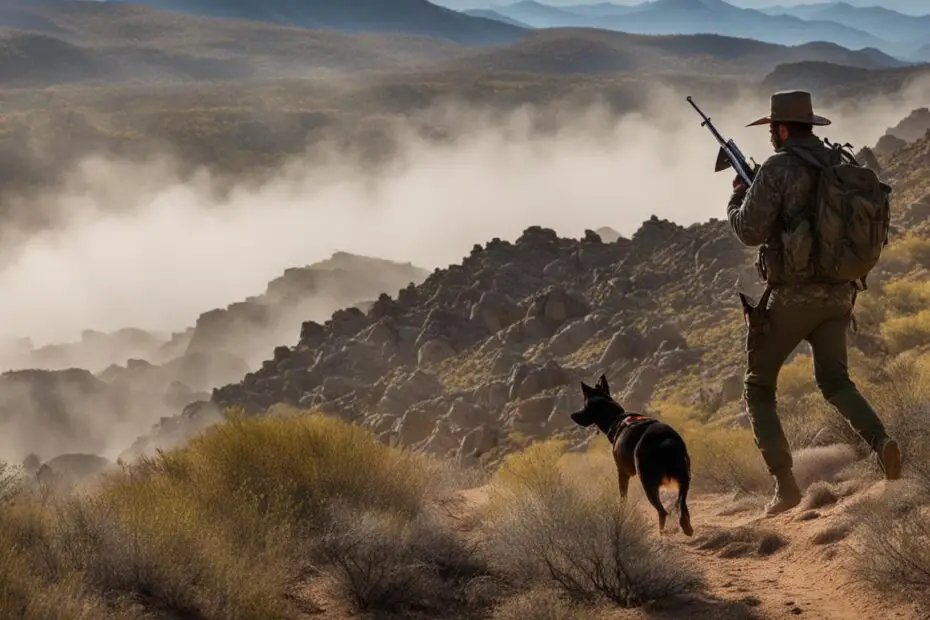New Mexico is a haven for rabbit hunting enthusiasts, offering a diverse range of species and ample hunting opportunities. Whether you’re a seasoned hunter or just starting out, the state’s unique landscapes and abundance of rabbits make it an ideal destination. In this article, we will explore the different rabbit species found in New Mexico, their habitats, hunting seasons, and provide valuable tips for a successful hunt.
Key Takeaways:
- Explore New Mexico’s two major jackrabbit species: black-tailed jackrabbit and white-tailed jackrabbit.
- Learn about the three cottontail species: desert cottontail, mountain cottontail, and eastern cottontail.
- Understand the preferred habitats and food habits of rabbits in New Mexico.
- Manage rabbit damage and familiarize yourself with the legal status of hunting in the state.
- Gain insights into effective hunting techniques and essential gear for a successful rabbit hunt.
Identifying New Mexico’s Rabbit Species
New Mexico is home to two species of jackrabbits – the black-tailed jackrabbit and the white-tailed jackrabbit. Let’s take a closer look at each:
Black-Tailed Jackrabbit
The black-tailed jackrabbit is larger in size. It has a grayish brown body with black-tipped ears and a black streak on its tail. This species is known for its incredible speed and agility, making it a challenging target for hunters.
White-Tailed Jackrabbit
The white-tailed jackrabbit is slightly smaller compared to its black-tailed counterpart. It has a brownish gray body with large black-tipped ears and a distinct white tail. This species is well-adapted to the open plains of New Mexico.
In addition to jackrabbits, New Mexico is also home to three species of cottontails:
Desert Cottontail
The desert cottontail is smaller in size and has pale gray fur washed with yellow. It is well-suited to the arid landscapes of New Mexico, often found in open plains, foothills, and low valleys.
Mountain Cottontail
The mountain cottontail is similar to the eastern cottontail but somewhat paler. It can be found in the northern regions of New Mexico, particularly in thickets, sagebrush, and cliffs.
Eastern Cottontail
The eastern cottontail is the most widespread species of cottontail in New Mexico. It prefers heavy brush, forest strips near open areas, and weed patches. The eastern cottontail is adaptable and can thrive in a variety of habitats.
Understanding the differences between these rabbit species is essential for successful hunting in New Mexico.

| Rabbit Species | Distinctive Features |
|---|---|
| Black-Tailed Jackrabbit | Grayish brown body with black-tipped ears and a black streak on its tail |
| White-Tailed Jackrabbit | Brownish gray body, large black-tipped ears, and a white tail |
| Desert Cottontail | Smaller size, pale gray fur washed with yellow |
| Mountain Cottontail | Similar to the eastern cottontail, but somewhat paler |
| Eastern Cottontail | Adaptable with a preference for heavy brush and forest strips |
Understanding Rabbit Habitat and Food Habits
When it comes to rabbits in New Mexico, understanding their habitat and food habits is essential for successful hunting and conservation efforts. Different rabbit species have specific preferences for habitat and food sources, allowing them to thrive in their respective environments.
Rabbit Habitat in New Mexico
Jackrabbits and cottontails in New Mexico occupy distinct habitats that cater to their needs. Let’s take a closer look at where each species is commonly found:
- White-tailed and Black-tailed Jackrabbits: These jackrabbits prefer semi-open, grassy or sagebrush plains, as well as sparsely vegetated deserts. They are adaptable to arid regions and can survive in harsh conditions.
- Eastern Cottontail: This species is commonly found in heavy brush, forest strips near open areas, and weed patches. It seeks shelter and protection in areas with dense vegetation.
- Mountain Cottontail: Mountain cottontails are associated with thickets, sagebrush, and cliffs. They are often found in rugged terrains with abundant hiding spots.
- Desert Cottontail: The desert cottontail prefers open plains, foothills, and low valleys. It thrives in arid regions and is well-adapted to desert environments.
By understanding the preferred habitats of each rabbit species, hunters can strategically plan their hunting locations and increase their chances of success. Respect for the natural habitat of rabbits is also essential for their conservation.
Rabbit Food Habits
Food sources play a crucial role in the survival and reproduction of rabbits. They have distinctive food habits based on their available resources and seasonal changes:
- Rabbits primarily feed on vegetation, including grasses, leaves, twigs, buds, and even bark.
- In New Mexico, rabbits consume a variety of plants, such as mesquite, cacti, sagebrush, and various grass species.
- The type of vegetation rabbits eat may vary depending on the season and availability of food. During leaner months, they rely on woody plants or dried grasses, while in more favorable seasons, they consume green vegetation for optimal nutrition.
- Rabbit food habits often overlap with the food sources of other herbivores, such as deer and livestock, requiring them to compete for resources in some cases.
By understanding the food habits of rabbits, hunters can identify areas abundant in their preferred vegetation. This knowledge can be valuable when scouting for hunting locations and increasing the effectiveness of hunting techniques.

Observing the natural behaviors and adapting hunting strategies to these habits can lead to a more exciting and successful hunting experience in New Mexico.
Managing Rabbit Damage and Legal Status
Concentrations of rabbits can cause significant damage to orchards, gardens, and agricultural areas. They can also cause overbrowsing and overgrazing in range vegetation. It is important to implement exclusion methods to protect crops and range vegetation from rabbit damage.
Rabbit damage prevention strategies include:
- Installing fences or netting around vulnerable areas
- Using repellents or deterrents
- Practicing proper garden and orchard management to minimize attractive food sources
Additionally, understanding the legal status of rabbit hunting in New Mexico is crucial for responsible hunters. In New Mexico, jackrabbits and cottontails are considered nongame animals and are not protected by state game laws, except for the white-sided jackrabbit which is listed as a threatened species.
| Species | Protected Status |
|---|---|
| Black-tailed Jackrabbit | Not protected |
| White-tailed Jackrabbit | Not protected |
| Desert Cottontail | Not protected |
| Mountain Cottontail | Not protected |
| Eastern Cottontail | Not protected |
| White-sided Jackrabbit | Threatened |
Legal Considerations for Rabbit Hunting
Rabbit hunting laws in New Mexico must be followed to ensure compliance and ethical hunting practices. It is essential for hunters to review the current hunting regulations, obtain the necessary licenses and permits, and adhere to bag limits and season dates. Always hunt responsibly and prioritize the conservation of wildlife populations.

- New Mexico Department of Game and Fish
- United States Fish and Wildlife Service
Tips for Successful Rabbit Hunting
When it comes to hunting rabbits in New Mexico, understanding their habits and defensive strategies is key to a successful hunt. By employing effective rabbit hunting techniques and choosing the best places to hunt, you can increase your chances of a rewarding experience. Here are some valuable tips to help you maximize your rabbit hunting efforts:
- Flush them out: To flush rabbits out of hiding, walk slowly and quietly through their habitat, paying attention to any movement or noises. Be prepared for quick bursts of speed as rabbits dart away when startled.
- Choose the right habitat: Rabbits typically prefer areas with abundant cover, such as thickets, brush piles, or edges of fields. Look for signs of rabbit activity, such as tracks, droppings, and chewed vegetation, to identify productive hunting grounds.
- Invest in quality gear: Having the right rabbit hunting gear can greatly enhance your hunting experience. Consider wearing a blaze orange safety vest for visibility, thick clothing for protection against thorns and brush, and appropriate firearms such as a 20-gauge shotgun or a .22 rifle.
- Be patient and vigilant: Rabbits are wary and sensitive animals, so it’s important to exercise patience and remain alert while hunting. Take your time, move slowly, and carefully scan the area for any signs of rabbits.
By following these tips and employing effective rabbit hunting techniques, you can improve your chances of a successful hunt in New Mexico. Remember to adhere to all hunting regulations and obtain any necessary licenses or permits before embarking on your hunting adventure.
Recommended Rabbit Hunting Outfitters in New Mexico
If you’re new to rabbit hunting or prefer the guidance of experienced professionals, consider booking a hunt with one of New Mexico’s reputable rabbit hunting outfitters. These outfitters can provide you with expert guidance, access to prime hunting locations, and a memorable hunting experience. Here are some recommended rabbit hunting outfitters in New Mexico:
“New Mexico Rabbit Hunting Outfitters is dedicated to providing hunters with exceptional rabbit hunting opportunities. With experienced guides and access to premium hunting areas, they offer customized hunting packages tailored to your preferences. Contact them at [email protected] or visit their website at www.nmrabbitoutfitters.com.”
“Southwest Rabbit Hunting Adventures offers guided rabbit hunts in the breathtaking landscapes of southern New Mexico. Their knowledgeable guides will take you to the best rabbit hunting spots and ensure a memorable hunting experience. For more information, visit their website at www.southwestrabbithunts.com or contact them at [email protected]”
Booking a hunt with a rabbit hunting outfitter can provide you with a stress-free and enjoyable hunting experience. They can take care of all the logistics, allowing you to focus on the thrill of the hunt.

Explore these diverse regions and discover the joy of rabbit hunting in their unique landscapes. Whether you choose the pinon juniper hills of Northern New Mexico or the picturesque blackberry patches of the Willamette Valley, each region offers a distinct hunting experience.
Dressing and Cooking Rabbit
After successfully hunting a rabbit, it is important to properly dress and prepare the meat. Dressing a rabbit involves removing the entrails and preparing the carcass for cooking. Rabbit meat can be cooked in various ways, but a popular choice is rabbit stew. Braise the rabbit meat first for added flavor, and then incorporate it into a stew recipe. Rabbit meat has a gamey taste that many hunters enjoy.
Here is a simple yet delicious rabbit stew recipe:
| Ingredients | Instructions |
|---|---|
|
|
Enjoy the flavorful and tender rabbit stew, a perfect way to savor the deliciousness of your hunting success!
Conclusion
Rabbit hunting in New Mexico provides hunters with an exhilarating and challenging experience. To ensure successful hunts, it is crucial to have a comprehensive understanding of the different rabbit species, their habitats, and their habits. By implementing the tips and techniques discussed in this article and exploring the diverse hunting regions in New Mexico, hunters of all skill levels can embark on a rewarding rabbit hunting adventure.
Whether you prefer hunting the swift and elusive jackrabbits in the juniper flats or stalking the brushy areas for cottontails, rabbit hunting in New Mexico offers a unique and enjoyable pastime. The state’s abundant wildlife and varied landscapes provide a perfect backdrop for thrilling hunts and unforgettable experiences in the great outdoors.
Remember to always practice safe hunting techniques and abide by the regulations defined by the New Mexico Department of Game and Fish. By respecting the land and the animals you hunt, you can contribute to the preservation and sustainable management of these precious resources for generations to come. So gear up, embrace the challenge, and immerse yourself in the world of rabbit hunting in the beautiful state of New Mexico.
FAQ
What are the most common rabbit species in New Mexico?
The most common rabbit species in New Mexico are the black-tailed jackrabbit, white-tailed jackrabbit, desert cottontail, mountain cottontail, and eastern cottontail.
When is rabbit hunting season in New Mexico?
Rabbit hunting season in New Mexico typically occurs in the winter months.
Are rabbits protected by hunting regulations in New Mexico?
Jackrabbits and cottontails are considered nongame animals in New Mexico and are not protected by state game laws, except for the white-sided jackrabbit which is listed as a threatened species.
What are the best places to hunt rabbits in New Mexico?
Popular rabbit hunting locations in New Mexico include pinon juniper hills, sagebrush flats, brushy areas with prickly pears, and areas with juniper and sagebrush cover.
What gear do I need for rabbit hunting in New Mexico?
It is recommended to wear a blaze orange safety vest, thick clothing, and consider using a 20-gauge shotgun or a .22 rifle for rabbit hunting.
What are some tips for successful rabbit hunting?
To increase your chances of success, be patient, choose the right habitat, understand rabbit habits and defensive strategies, and be cautious and aware while hunting.
How do I dress and cook rabbit?
Dressing a rabbit involves removing the entrails and preparing the carcass for cooking. Rabbit meat can be cooked in various ways, but a popular choice is rabbit stew.


